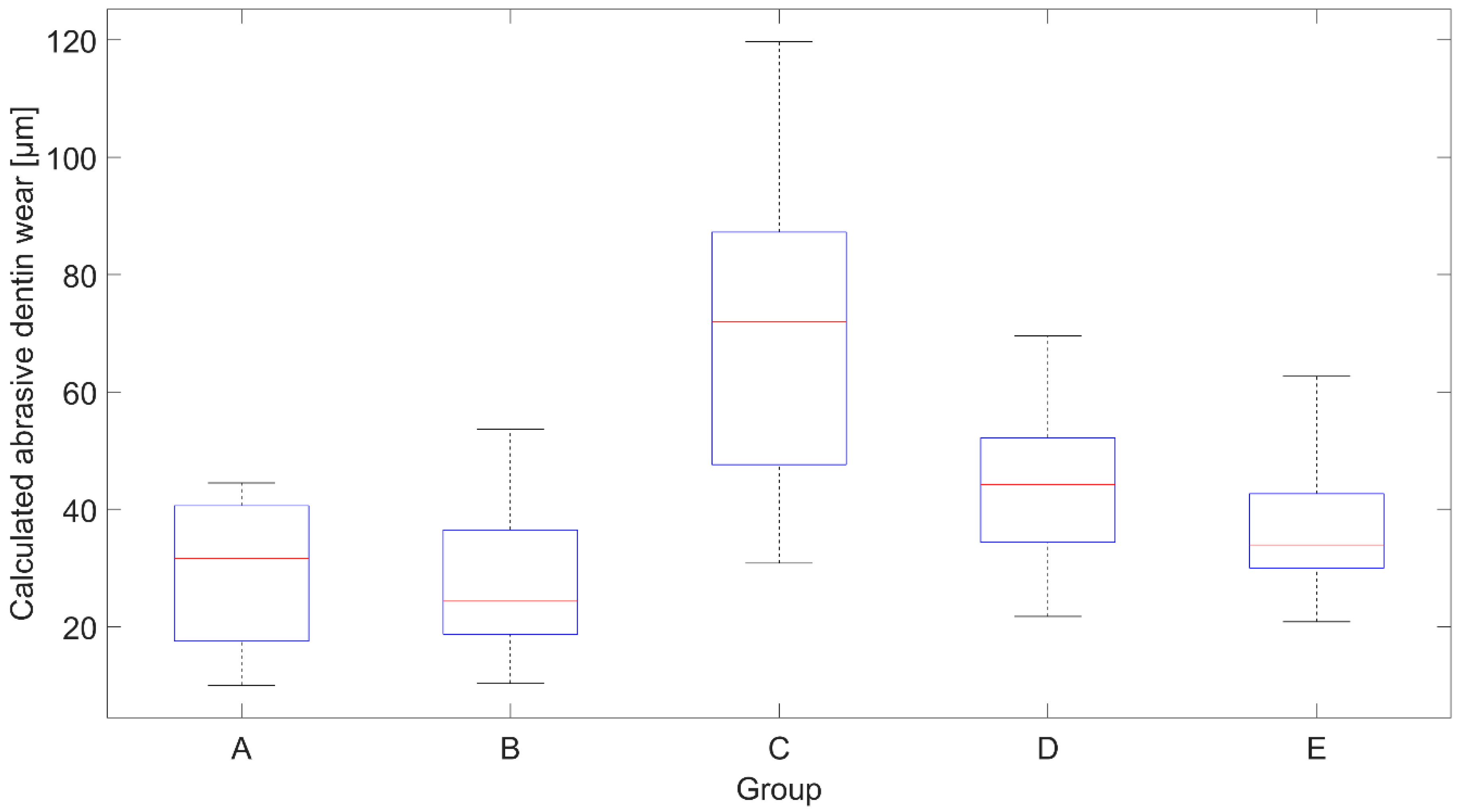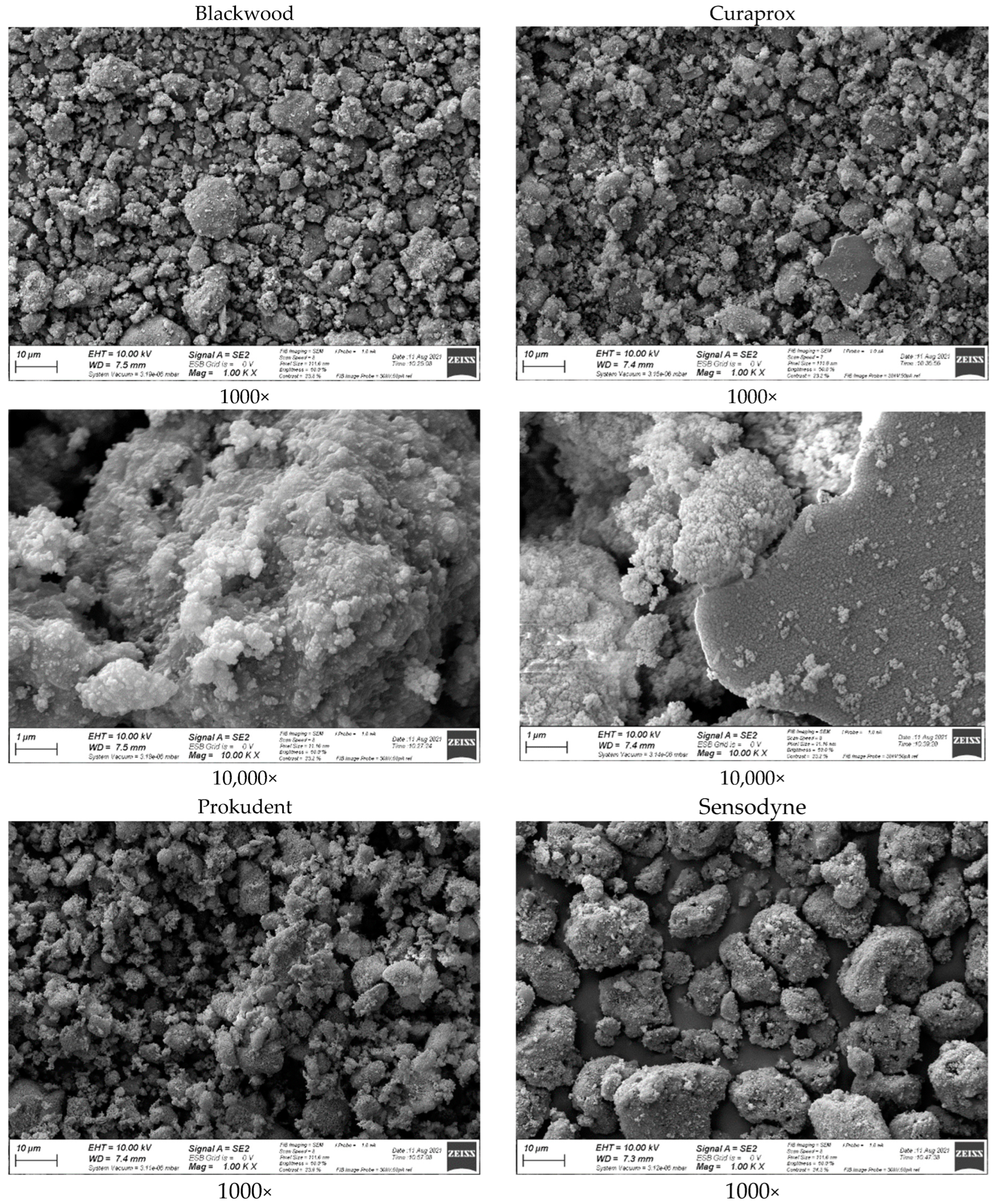Abrasion Behavior of Different Charcoal Toothpastes on Human Dentin When Using Electric Toothbrushes
Abstract
:1. Introduction
2. Materials and Methods
2.1. Sample Preparation
2.2. Profilometry and Calculation of Substance Loss
2.3. Brushing
2.4. Thermogravimetric Analysis and REM Analysis
2.5. Statistics
3. Results
4. Discussion
5. Conclusions
Author Contributions
Funding
Institutional Review Board Statement
Informed Consent Statement
Data Availability Statement
Acknowledgments
Conflicts of Interest
References
- Thakur, A.; Ganeshpurkar, A.; Jaiswal, A. Charcoal in Dentistry. Nat. Oral Care Dent. Ther. 2020, 197–209. [Google Scholar] [CrossRef]
- Greenwall, L.H.; Greenwall-Cohen, J.; Wilson, N.H.F. Charcoal-containing dentifrices. Br. Dent. J. 2019, 226, 697–700. [Google Scholar] [CrossRef] [PubMed]
- Brooks, J.K.; Bashirelahi, N.; Reynolds, M.A. Charcoal and charcoal-based dentifrices: A literature review. J. Am. Dent. Assoc. 2020, 148, 661–670. [Google Scholar] [CrossRef] [PubMed]
- Palandi, S.; Kury, M.; Picolo, M.Z.D.; Coelho, C.S.S.; Cavalli, V. Effects of activated charcoal powder combined with toothpastes on enamel color change and surface properties. J. Esthet. Restor. Dent. 2020, 32, 783–790. [Google Scholar] [CrossRef]
- Vural, U.K.; Bagdatli, Z.; Yilmaz, A.E.; Çakır, F.Y.; Altundaşar, E.; Gurgan, S. Effects of charcoal-based whitening toothpastes on human enamel in terms of color, surface roughness, and microhardness: An in vitro study. Clin. Oral Investig. 2021, 25, 5977–5985. [Google Scholar] [CrossRef] [PubMed]
- Vaz, V.T.P.; Jubilato, D.P.; De Oliveira, M.R.M.; Bortolatto, J.F.; Floros, M.C.; Dantas, A.; Junior, O.B.D.O. Whitening toothpaste containing activated charcoal, blue covarine, hydrogen peroxide or microbeads: Which one is the most effective. J. Appl. Oral Sci. 2019, 27, e20180051. [Google Scholar] [CrossRef] [PubMed]
- Addy, M. Tooth brushing, tooth wear and dentine hypersensitivity-Are they associated? Int. Dent. J. 2005, 55, 261–267. [Google Scholar] [CrossRef] [PubMed]
- Hunter, M.; Addy, M.; Pickles, M.; Joiner, A. The role of toothpastes and toothbrushes in the aetiology of tooth wear. Int. Dent. J. 2002, 52, 399–405. [Google Scholar] [CrossRef]
- Joiner, A.; Pickles, M.J.; Lynch, S.; Cox, T. The measurement of enamel wear by four toothpastes. Int. Dent. J. 2008, 58, 23–28. [Google Scholar] [CrossRef] [PubMed]
- Addy, M.; Pearce, N. Aetiological, predisposing and environmental factors in dentine hypersensitivity. Arch. Oral Biol. 1994, 39, S33–S38. [Google Scholar] [CrossRef]
- Addy, M.; Hughes, J.; Pickles, M.J.; Joiner, A.; Huntington, E. Development of a method in situ to study toothpaste abrasion of dentine. J. Clin. Periodontol. 2002, 29, 896–900. [Google Scholar] [CrossRef]
- Joiner, A.; Collins, L.Z.; Cox, T.; Pickles, M.J.; Weader, E.; Liscombe, C.; Holt, J.S. The measurement of enamel and dentine abrasion by tooth whitening products using an in-situ model. Int. Dent. J. 2005, 55, 194–196. [Google Scholar] [CrossRef] [PubMed]
- João-Souza, S.H.; Lussi, A.; Baumann, T.; Scaramucci, T.; Aranha, A.C.C.; Carvalho, T.S. Chemical and physical factors of desensitizing and/or anti-erosive toothpastes associated with lower erosive tooth wear. Sci. Rep. 2017, 7, 17909. [Google Scholar] [CrossRef] [PubMed] [Green Version]
- Wiegand, A.; Kuhn, M.; Sener, B.; Roos, M.; Attin, T. Abrasion of eroded dentin caused by toothpaste slurries of different ablativity and toothbrushes of different filament diameter. J. Dent. 2009, 37, 480–484. [Google Scholar] [CrossRef] [PubMed] [Green Version]
- Vertuan, M.; de Souza, B.M.; Machado, P.F.; Mosquim, V.; Magalhães, A.C. The effect of commercial whitening toothpastes on erosive dentin wear in vitro. Arch. Oral Biol. 2019, 109, 104580. [Google Scholar] [CrossRef] [PubMed]
- Pertiwi, U.I.; Eriwati, Y.K.; Irawan, B. Surface changes of enamel after brushing with charcoal toothpaste. J. Phys. Conf. Ser. 2017, 884, 012002. [Google Scholar] [CrossRef] [Green Version]
- Greuling, A.; Emke, J.M.; Eisenburger, M. Abrasion Behaviour of Different Charcoal Toothpastes When Using Electric Toothbrushes. Dent. J. 2021, 9, 97. [Google Scholar] [CrossRef] [PubMed]
- EN ISO 11609:2017; Dentistry-Dental Cleaning Products-Requirements, Test Methods and Classification. ISO: Geneva, Switzerland, 2017.
- ISO/TR 14569-1:2007; Dental Materials—Guidance on Testing of Wear—Part 1: Wear by Toothbrushing. ISO: Geneva, Switzerland, 2007.
- GSK Customer Support by Email Inquiry. Available online: https://www.gsk.com (accessed on 11 May 2021).
- Coldmooncosmetics. Available online: https://www.coldmooncosmetics.de/marken/splat/ (accessed on 11 May 2021).
- Curaprox. Available online: https://www.curaprox.com/data/downloads/81427791789Black_Is_White_d.pdf (accessed on 11 May 2021).
- Rossmann Customer Support by Email Inquiry. Available online: https://business.rossmann.de (accessed on 14 May 2021).
- Tawakoli, P.N.; Becker, K.; Attin, T. Abrasive effects of diamond dentifrices on dentine and enamel. Swiss Dent. J. 2018, 128, 14–19. [Google Scholar]
- Marshall, G.W., Jr. Dentin: Microstructure and characterization. Quintessence Int. 1993, 24, 606–617. [Google Scholar]
- Garberoglio, R.; Brännström, M. Scanning electron microscopic investigation of human dentinal tubules. Arch. Oral Biol. 1976, 21, 355–362. [Google Scholar] [CrossRef]
- Kinney, J.H.; Balooch, M.; Marshall, S.J.; Marshall, G.W.; Weihs, T.P. Atomic force microscope measurements of the hardness and elasticity of peritubular and intertubular human dentin. J. Biomech. Eng. 1996, 118, 133–135. [Google Scholar] [CrossRef] [PubMed]
- Goldberg, M.; Kulkarni, A.B.; Young, M.; Boskey, A. Dentin: Structure, composition and mineralization. Front. Biosci. 2011, E3, 711–735. [Google Scholar] [CrossRef] [PubMed]
- Prencipe, M.; Vandeven, M.; Feldman, B.N.; Schemehorn, B.R. A Comparative Study of Laboratory Dentifrice Abrasion Measuring Methods. J. Clin. Dent. 2016, 27, 105–109. [Google Scholar] [PubMed]
- Welss, T.; Hundeiker, C.; Förster, T. Balance of Cleaning Efficacy and Dental Hard Tissue Abrasive Wear: An In Vitro Study Assessing Toothpaste Effects Associated with Manual or Powered Toothbrushes. Int. Fed. Soc. Cosmet. Chem. Mag. 2014, 3, 37–41. [Google Scholar]
- Gåhlin, R.; Jacobson, S. The particle size effect in abrasion studied by controlled abrasive surfaces. Wear 1999, 224, 118–125. [Google Scholar] [CrossRef]
- Baig, M.; Cook, R.; Pratten, J.; Wood, R. Evolution of wear on enamel caused by tooth brushing with abrasive toothpaste slurries. Wear 2020, 476, 203580. [Google Scholar] [CrossRef]
- Lippert, F. An introduction to toothpaste-its purpose, history and ingredients. Monogr. Oral Sci. 2013, 23, 1–14. [Google Scholar] [CrossRef]




| Group | Commercial Brand | Ingredients 1 | Expiration Date/Batch Number as Given on Toothpaste Packaging |
|---|---|---|---|
| A | - | Aqua | - |
| B | Sensodyne Pro Schmelz Repair Zahnschmelz, conventional (no charcoal) | Hydrated Silica, Aqua, Sorbitol, Glycerin, Potassium Nitrate, PEG-6, Sodium Lactate, Cocamidopropyl Betaine, Aroma, Titanium Dioxide, Xanthan Gum, Sodium Saccharin, Sodium Fluoride (1450 ppm F−), PVM/MA Copolymer, Sodium Hydroxide, Limonene | EXP 200823 02942KWA |
| C | Splat Blackwood | Hydrated Silica, Charcoal Powder, Aqua, Hydrogenated Starch Hydrolysate, Glycerin, Maltooligosyl Glucoside, Sodium Lauroyl Sarcosinate, Cellulose Gum, Aroma, Capryloyl/Caproyl Methyl Glucamide, Lauroyl/Myristoyl Methyl Glucamide, Sodium Benzoate, Stevia Rebaudiana Leaf Extract, Potassium Sorbate, Menthol o-Cymen-5-ol, Juniperus Communis Sprout Extract, Limonene | R02 EXP 12.23 |
| D | Curaprox Black is White | Hydrated Silica, Charcoal Powder, Aqua, Sorbitol, Glycerin, Aroma, Decyl Glucoside, Cocamidropropyl Betaine, Sodium Monofluorophosphate 950 ppm F−, Tocopherol, Xanthan Gum, Maltodextrin, Mica, Hydroxylapatite (Nano), Potassium Acesulfame, Titanium Dioxide, Microcrystalline Cellulose, Sodium Chloride, Citrus Limon Peel Oil, Sodium Hydroxide, Zea Mays Starch, Amyloglucosidase, Glucose Oxidase, Urtica Dioca Leaf Extract, Potassium Thiocyanate, Cetearyl Alcohol, Hydrogenated Lecithin, Menthyl Lactate, Methyl Diisopropyl Propionamide, Ethyl Menthane Carboxamide, Stearic Acid, Mannitol, Sodium Bisulfite, Tin Oxide, Lactoperoxidase, Limonene | 400MHDEXP1021 |
| E | Prokudent Black Brilliant | Hydrated Silica, Charcoal Powder, Aqua, Sorbitol, Propylene Glycol, Pentasodium Triposphate, Tetrapotassium Pyrophosphate, Sodium C14-16 Olefin Sulfonate, Aroma, Disodium Pyrophosphate, Xanthan Gum, Menthol, Sodium Fluoride (1450 ppm F−), Sodium Saccharin | 025377 B |
| Group | RDA | Mean Abrasive Dentin Wear [µm] | SD Abrasive Dentin Wear [µm] | Mean Abrasive Enamel Wear [µm] | SD Abrasive Enamel Wear [µm] |
|---|---|---|---|---|---|
| A | - | 28 a | 13 | 1.71 | 0.63 |
| B | 35 ± 15% [20] | 28 a | 14 | 2.32 | 0.69 |
| C | 75 [21] | 71 b | 28 | 4.55 | 0.60 |
| D | 50 [22] | 44 a | 16 | 3.25 | 0.85 |
| E | 120 [23] | 38 a | 13 | 1.45 | 0.61 |
| Group | Toothpaste Total Solids Content [wt%] | Weight Loss above 650 °C [wt%] | Inorganic Residue after TGA [wt%] | Activated Charcoal Content in Toothpaste [wt%] | Inorganic Content in Toothpaste [wt%] |
|---|---|---|---|---|---|
| B | 27.62 | 1.20 | 68.59 | - | 18.95 |
| C | 36.60 | 3.35 | 78.37 | 1.23 | 28.68 |
| D | 30.21 | 19.75 | 52.40 | 5.97 | 15.83 |
| E | 21.81 | 4.50 | 69.18 | 0.98 | 15.08 |
Publisher’s Note: MDPI stays neutral with regard to jurisdictional claims in published maps and institutional affiliations. |
© 2022 by the authors. Licensee MDPI, Basel, Switzerland. This article is an open access article distributed under the terms and conditions of the Creative Commons Attribution (CC BY) license (https://creativecommons.org/licenses/by/4.0/).
Share and Cite
Osmanaj, N.; Petersen, S.; Eisenburger, M.; Greuling, A. Abrasion Behavior of Different Charcoal Toothpastes on Human Dentin When Using Electric Toothbrushes. Dent. J. 2022, 10, 46. https://doi.org/10.3390/dj10030046
Osmanaj N, Petersen S, Eisenburger M, Greuling A. Abrasion Behavior of Different Charcoal Toothpastes on Human Dentin When Using Electric Toothbrushes. Dentistry Journal. 2022; 10(3):46. https://doi.org/10.3390/dj10030046
Chicago/Turabian StyleOsmanaj, Nadin, Svea Petersen, Michael Eisenburger, and Andreas Greuling. 2022. "Abrasion Behavior of Different Charcoal Toothpastes on Human Dentin When Using Electric Toothbrushes" Dentistry Journal 10, no. 3: 46. https://doi.org/10.3390/dj10030046
APA StyleOsmanaj, N., Petersen, S., Eisenburger, M., & Greuling, A. (2022). Abrasion Behavior of Different Charcoal Toothpastes on Human Dentin When Using Electric Toothbrushes. Dentistry Journal, 10(3), 46. https://doi.org/10.3390/dj10030046






